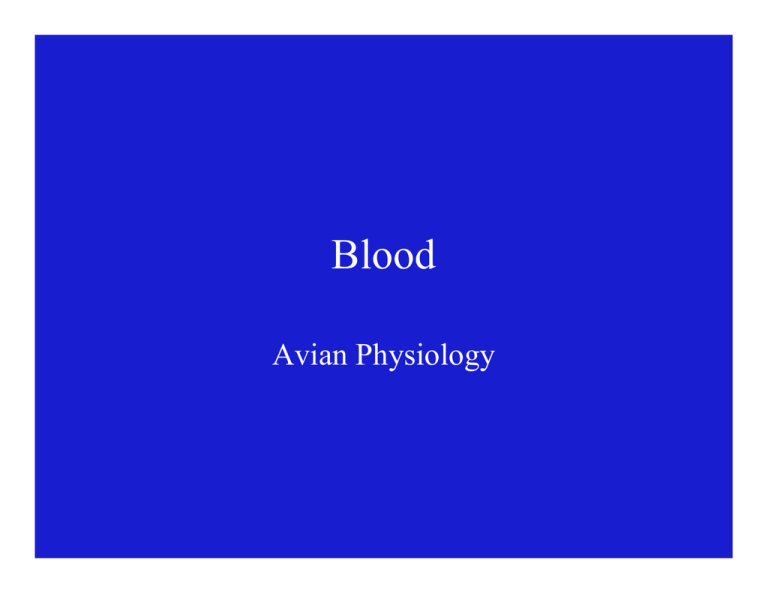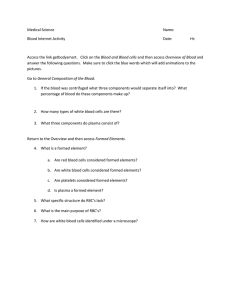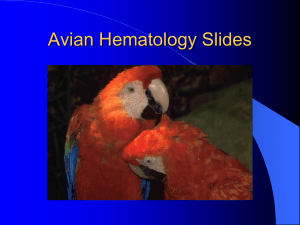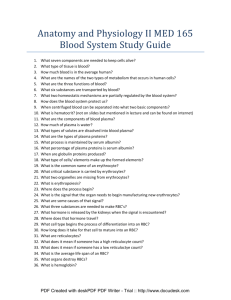Blood Avian Physiology
advertisement

Blood Avian Physiology Corpuscles • Erythrocytes = Red blood cells (RBC) • Leukocytes = white blood cells (WBC) • Thrombocytes = similar to platelets in mammals • All are nucleated in birds, but in mammals RBC and platelets are not nucleated • RBC and platelets are biconcave disc in mammals but football shaped in birds. Erythrocytes or red blood cells • ~3 million (106) per mm3 • Nucleated • Male > female – Because androgens ↑RBC formation and estrogens ↓ RBC formation • Formed in bone marrow as well as liver, spleen, and thymus at times in birds life. • Lifespan 28-35 days (cf. 120 days in human) Avian RBC maturation-The younger cells are smaller, rounder and have a more basophilic cytoplasm. Mature erythrocytes are oval with eosinophilic cytoplasm. The nuclear size decreases and the amount of cytoplasm increases as the cell matures. Polychromatic (younger) RBCs Basophilic (even younger) erythroblast Mature erythrocytes This is a very young red blood cell or basophilic erythroblast. Also present are some polychromatic and mature erythrocytes. Polychromatic erythrocytes Basophilic erythroblast Mature erythrocytes Red Blood Cells Formation • Erythropoiesis = process of RBC formation • Erythropoietin (EPO)= kidney hormone that controls erythropoiesis – Increased at high altitudes – Glycoprotein hormone – Stimulates red blood cell formation – Humans - Anemia Treatment – EPO = endurance. Erythrocytes or red blood cells Storage and Removal • Spleen stores RBC in mammals • Bone marrow stores RBC in birds, little spleen storage • Phagocytes remove dead and dying RBC. • Kupffer cells= stationary macrophages (phagocytes were monocytes) in liver that remove RBC. Erythrocytes or red blood cells Functions • Transport hemoglobin • Hemoglobin transports – Oxygen – CO2 • Convert carbon dioxide and water into carbonic acid and vice versa – Carbonic anhydrase enzyme – CO2 + H2O H2CO3 H CO3+ (bicarbonate)+H+ – Maintains acid base balance = osmotic regulation Erythrocytes or red blood cells Hemoglobin (Hb) • Made by RBC and not bone marrow • 8-12 g/dl in chicken blood • Mean corpuscular hemoglobin (MCHb) = – Amount of Hb in RBC = 50 pg/cell • Mean corpuscular hemoglobin concentration (MCHC)= – Relative volume of RBC that is Hb = 25% Erythrocytes or red blood cells Hemoglobin (Hb) Structure • 4 heme molecules + 4 polypeptide chains (globulins) • Each heme molecule contains one Fe molecule • Each Fe molecule can carry one O2 molecule • Therefore each hemoglobin molecule carries 4 O2 molecules Erythrocytes or red blood cells Hemoglobin (Hb) Structure • The protein subunits are in red and blue, and the iron-containing heme groups in green. Red Blood Cells Anemia • Physiopathological term meaning: – Reduction in circulating RBC numbers or – A deficiency of hemoglobin in blood • 4 types of anemia Anemia - 4 types • Hemorrhagic = excessive blood (RBC) loss • Aplastic = due to drugs, irradiation – To much coccidiastat – Common in older animals • Pernicious = bone marrow doesn’t make RBC – Lack of Vit. B12 in diet or absorption of B12 – B12 intrinsic factor – mucoprotein secreted by intestines to help in B12 uptake • Hemolytic – intravascular explosion of RBC – Genetic, recessive trait – Made worse by high temp, poor diet, toxins Red Blood Cells Excess • Polycythemia: – Excess RBC – Not pathological – Occurs as a result of need for oxygen – Adaptation that occurs when animals are reared at high elevations Polycythemia: Normal: White blood cells or Leukocytes • Cells of the immune system • Defend the body against infectious diseases and foreign materials • Derived from a multipotent cell known as a hematopoietic stem cell • Found in the blood and lymphatic system White blood cells or Leukocytes • ~ 20,000 per mm3 – if healthy • Produced by: – Bone marrow – Liver – Lymphoid tissue • Bursa of Fabricius • Spleen • Thymus • Gut Associated Lymphoid Tissue (GALT) –Peyer’s Patches White blood cell or Leukocyte Types • Agranulocytes or nonpolymorphonuclear leukocytes – Monocytes – Lymphocytes • Granulocytes or polymorphonuclear leukocytes – Heterophils – Eosinophils – Basophils White Blood Cells Agranulocytes • Monocytes – 5-15% of total WBC count This is a monocyte. Note the indented nucleus, and the abundant amount of light blue cytoplasm. This helps to distinguish it from a lymphocyte, which has a smaller proportion of cytoplasm. Monocyte Here you see a monocyte with an indented nucleus and some vacuoles. Above it is a heterophil. Agranulocytes • Lymphocytes – Most numerous of all – 60-80% of WBC This blood is from a white-winged dove. Their lymphocytes have granules in the cytoplasm. Lymphocyte This shows mature red cells, a young (polychromatic) red blood cell and a lymphocyte. Note how the lymph is molded around the adjacent RBCs. Polychromatic RBC Lymphocyte This is an example of a lymphocyte that has irregular cytoplasmic projections, known as blebs. Another lymph with blebs Granulocytes • Heterophils – 20-30% of total WBC count These are typical avian white blood cells. The heterophil (on the right) is round with round red granules in the clear cytoplasm. The eosinophil is also round with a blue-gray cytoplasm and stains more noticeably than the heterophil. Eosinophil Heterophil This is an example of a heterophil that is broken, revealing rod-shaped, red granules. Granulocytes • Eosinophils – 1-3% of WBC This is another example of an avian eosinophil. Granulocytes • Basophils – 0.5-2% of WBC This is an example of a basophil. The cell is round and contains a nucleus that is light blue in color. It has a large number of deeply basophilicstaining granules that almost cover the nucleus. Thrombocytes • • • • • ~ 30,000 per mm3 No platelets Smaller than RBC Nucleated Clotting and inflammation – Probably release thromboplastin • Phagocytize foreign particles These are clumped thrombocytes. Note that they are small, usually more rounded than RBCs, hand have clear cytoplasm.








